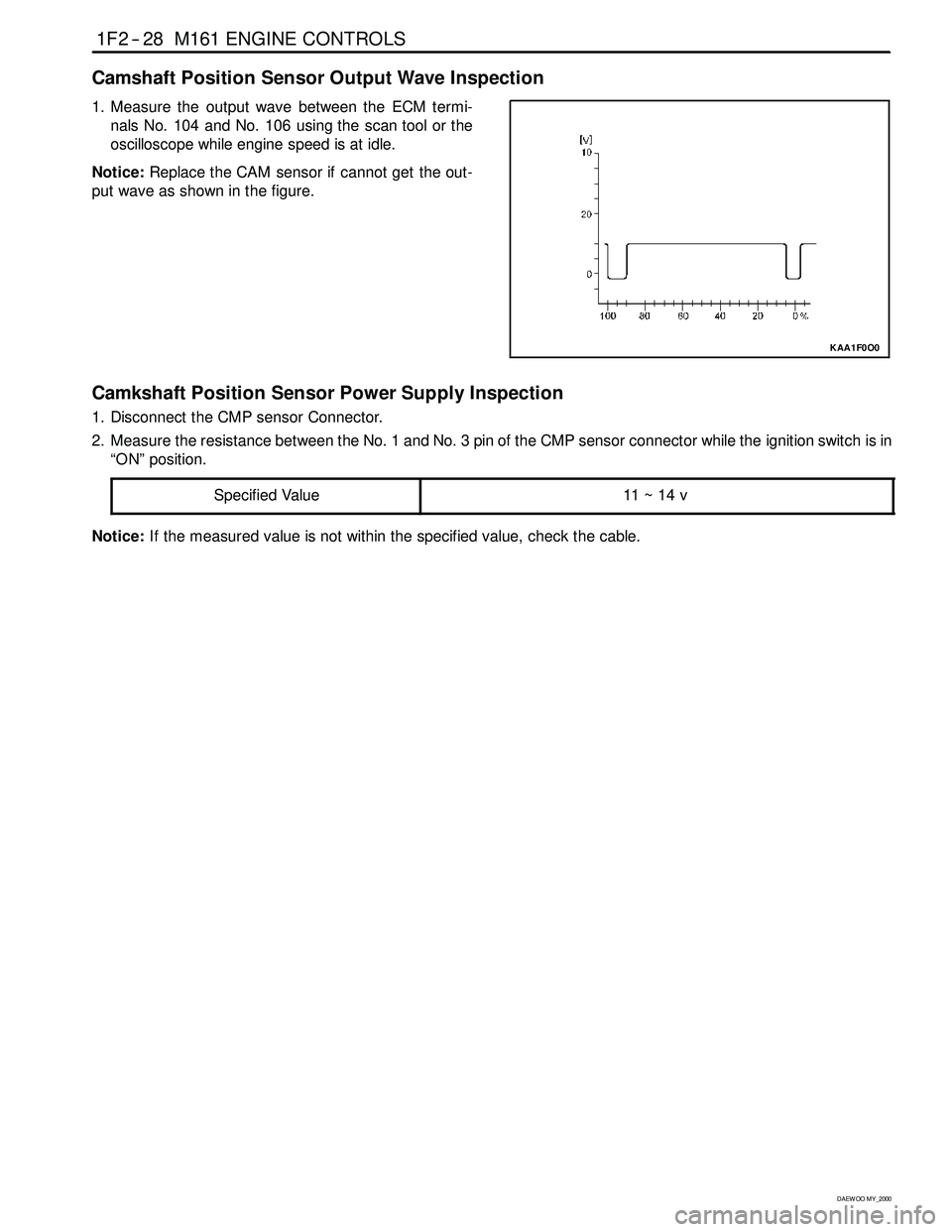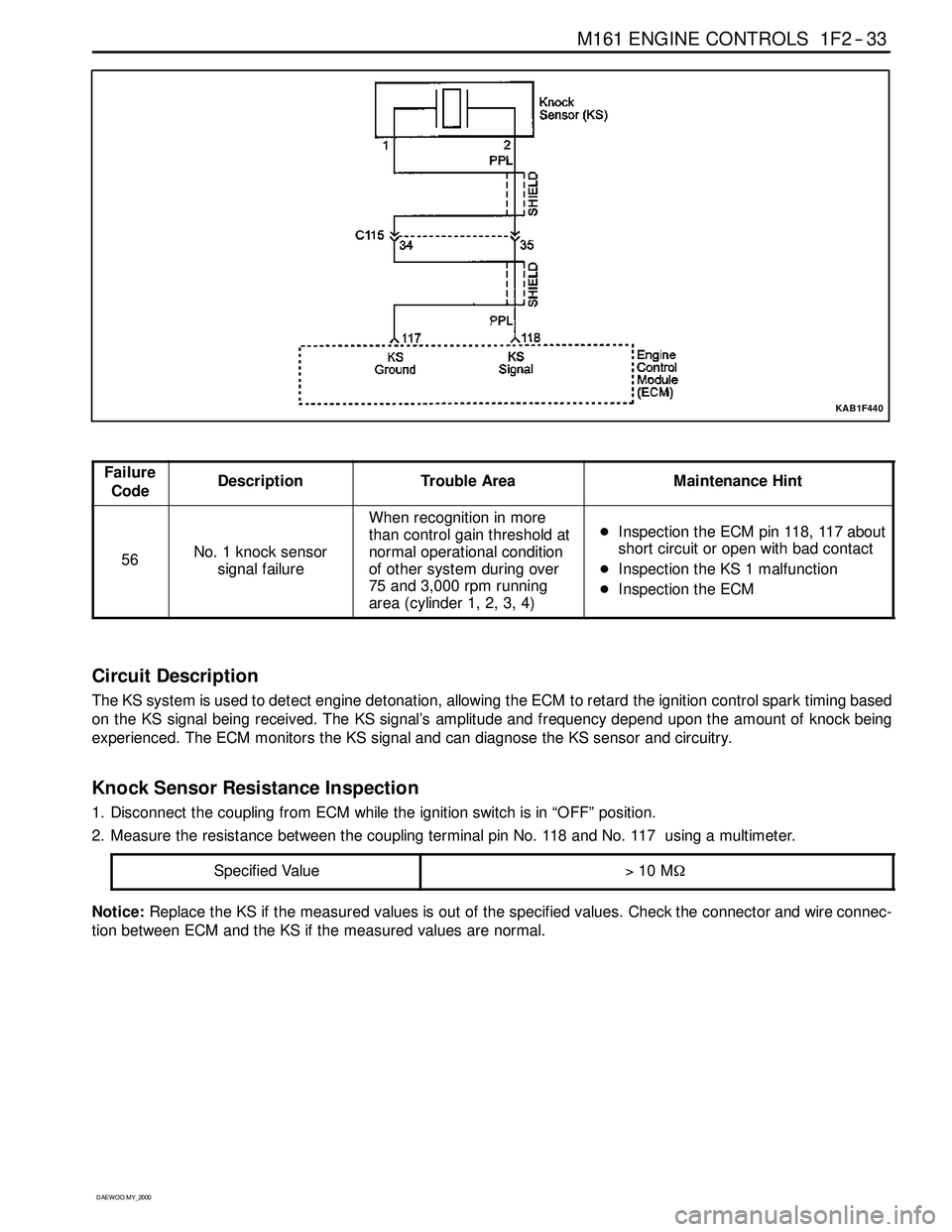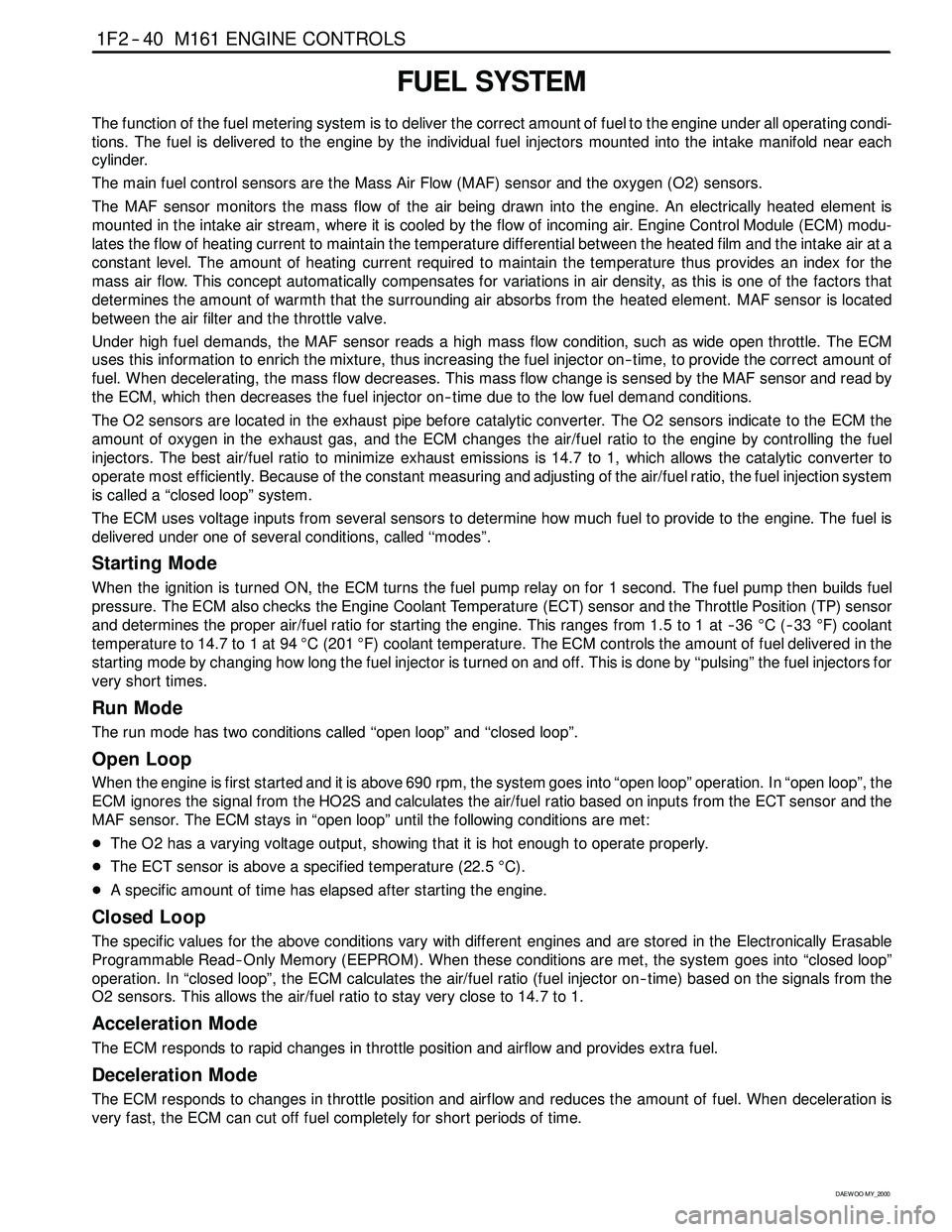check engine SSANGYONG KORANDO 1997 Service Repair Manual
[x] Cancel search | Manufacturer: SSANGYONG, Model Year: 1997, Model line: KORANDO, Model: SSANGYONG KORANDO 1997Pages: 2053, PDF Size: 88.33 MB
Page 448 of 2053

1F2 -- 28 M161 ENGINE CONTROLS
D AEW OO M Y_2000
Camshaft Position Sensor Output Wave Inspection
1. Measure the output wave between the ECM termi-
nals No. 104 and No. 106 using the scan tool or the
oscilloscope whileengine speed is at idle.
Notice:Replace the CAM sensor if cannot get the out-
put wave as shown in the figure.
KAA1F0O0
Camkshaft Position Sensor Power Supply Inspection
1. Disconnect the CMP sensor Connector.
2. Measure the resistance between the No. 1 and No. 3 pin of the CMP sensor connector while the ignition switch is in
“ON” position.
Specified Value
11 ~ 14 v
Notice:If the measured value is not within the specified value, check the cable.
Page 451 of 2053

M161 ENGINE CONTROLS 1F2 -- 33
D AEW OO M Y_2000
KAB1F440
Failure
CodeDescriptionTrouble AreaMaintenance Hint
56No. 1 knock sensor
signal failure
When recognition in more
than control gain threshold at
normal operational condition
of other system during over
75 and 3,000 rpm running
area (cylinder 1, 2, 3, 4)DInspection the ECM pin 118, 117 about
short circuit or open with bad contact
DInspection the KS 1 malfunction
DInspection the ECM
Circuit Description
The KS system is used to detect engine detonation, allowing the ECM to retard the ignition control spark timing based
on the KS signal being received. The KS signal’s amplitude and frequency depend upon the amount of knock being
experienced. The ECM monitors the KS signal and can diagnose the KS sensor and circuitry.
Knock Sensor Resistance Inspection
1. Disconnect the coupling from ECM while the ignition switch is in “OFF” position.
2. Measure the resistance between the coupling terminal pin No. 118 and No. 117 using a multimeter.
Specified Value
>10 MΩ
Notice:Replace the KS if the measured values is out of the specified values. Check the connector and wire connec-
tion between ECM and the KS if the measured values are normal.
Page 458 of 2053

1F2 -- 40 M161 ENGINE CONTROLS
D AEW OO M Y_2000
FUEL SYSTEM
The function of the fuel metering system is to deliver the correct amount of fuel to the engine under all operating condi-
tions. The fuel is delivered to the engine by the individual fuel injectors mounted into the intake manifold near each
cylinder.
The main fuel control sensors are the Mass Air Flow (MAF) sensor and the oxygen (O2) sensors.
The MAF sensor monitors the mass flow of the air being drawn into the engine. An electrically heated element is
mounted in the intake air stream, where it is cooled by the flow of incoming air. Engine Control Module (ECM) modu-
lates the flow of heating current to maintain the temperature differential between the heated film and the intake air at a
constant level. The amount of heating current required to maintain the temperature thus provides an index for the
mass air flow. This concept automatically compensates for variations in air density, as this is one of the factors that
determines the amount of warmth that the surrounding air absorbs from the heated element. MAF sensor is located
between the air filter and the throttle valve.
Under high fuel demands, the MAF sensor reads a high mass flow condition, such as wide open throttle. The ECM
uses this information to enrich the mixture, thus increasing the fuel injector on-- time, to provide the correct amount of
fuel. When decelerating, the mass flow decreases. This mass flow change is sensed by the MAF sensor and read by
the ECM, which then decreases the fuel injector on-- time due to the low fuel demand conditions.
The O2 sensors are located in the exhaust pipe before catalytic converter. The O2 sensors indicate to the ECM the
amount of oxygen in the exhaust gas, and the ECM changes the air/fuel ratio to the engine by controlling the fuel
injectors. The best air/fuel ratio to minimize exhaust emissions is 14.7 to 1, which allows the catalytic converter to
operate most efficiently. Because of the constant measuring and adjusting of the air/fuel ratio, the fuel injection system
is called a “closed loop” system.
The ECM uses voltage inputs from several sensors to determine how much fuel to provide to the engine. The fuel is
delivered under one of several conditions, called ‘‘modes”.
Starting Mode
When the ignition is turned ON, the ECM turns the fuel pump relay on for 1 second. The fuel pump then builds fuel
pressure. The ECM also checks the Engine Coolant Temperature (ECT) sensor and the Throttle Position (TP) sensor
and determines the proper air/fuel ratio for starting the engine. This ranges from 1.5 to 1 at -- 36°C(--33°F) coolant
temperature to 14.7 to 1 at 94°C (201°F) coolant temperature. The ECM controls the amount of fuel delivered in the
starting mode by changing how long the fuel injector is turned on and off. This is done by ‘‘pulsing” the fuel injectors for
very short times.
Run Mode
The run mode has two conditions called ‘‘open loop” and ‘‘closed loop”.
Open Loop
When the engine is first started and it is above 690 rpm, thesystem goes into “open loop” operation. In “open loop”, the
ECM ignores the signal from the HO2S and calculates the air/fuel ratio based on inputs from the ECT sensor and the
MAF sensor. The ECM stays in “open loop” until the following conditions are met:
DThe O2 has a varying voltage output, showing that it is hot enough to operate properly.
DThe ECT sensor is above a specified temperature (22.5°C).
DA specific amount of time has elapsed after starting the engine.
Closed Loop
The specific values for the above conditions vary with different engines and are stored in the Electronically Erasable
Programmable Read -- Only Memory (EEPROM). When these conditions are met, thesystem goes into “closed loop”
operation. In “closed loop”, the ECM calculates the air/fuel ratio (fuel injector on-- time) based on the signals from the
O2 sensors. This allows the air/fuel ratio to stay very close to 14.7 to 1.
Acceleration Mode
The ECM responds to rapid changes in throttle position and airflow and provides extra fuel.
Deceleration Mode
The ECM responds to changes in throttle position and airflow and reduces the amount of fuel. When deceleration is
very fast, the ECM can cut off fuel completely for short periods of time.
Page 462 of 2053

1F2 -- 44 M161 ENGINE CONTROLS
D AEW OO M Y_2000
Measure the Fuel Delivery from the Fuel Pump
1. Disconnect the return pipe from fuel distributor and insert the appropriate hose into it.
2. Place the hose end into the beaker with the minimum capacity of 1 Liter
3. Turn the ignition switch to “ON” position.
4. Connect the terminal No. 33 and No. 5 of ECM with a service wire.
5. Measure the fuel delivery from the fuel pump
Specified Value
1 Liter/max. 35 sec.
Notice:Check the fuel filter and fuel line when the fuel delivery is not within specified value.
Measure the Current Consumption of Fuel Pump
1. Remove the fuel pump relay from fuse and relay box in trunk, and turn the ignition switch to “ON” position.
2. Using a multimeter, measure the current consumption by connecting the terminal No. 30 and No. 87 of the fuel
pump relay connector.
Specified Value
5~9A
Notice:Replace the fuel pump relay if the measured value is over 9 A.
Page 466 of 2053

1F2 -- 48 M161 ENGINE CONTROLS
D AEW OO M Y_2000
Failure
CodeDescriptionTrouble AreaMaintenance Hint
77No. 3 injector short
circuit to ground or open
When malfunction of injector
circuit
Injector #3 short circuit to
ground or openDInspection the ECM pin 65 about short
circuit or open with bad contact
DInspection the injector
DInspection the ECM
78No. 4 injector short
circuit to battery
When malfunction of injector
circuit
Injector #4 short circuit to
powerDInspection the power to injector #4 or
bad contact
DInspection the injector
DInspection the ECM
79No. 4 injector short
circuit to ground or open
When malfunction of injector
circuit
Injector #4 short circuit to
ground or openDInspection the ECM pin 66 about short
circuit or open with bad contact
DInspection the injector
DInspection the ECM
YAA1F420YAA1F430
Injector Spray Pattern Check
1. Turn the ignition switch OFF.
2. Remove the fuel injector connectors.
3. Remove the fuel distributor and injector with a unit. At this time, do not remove the supply and return line.
Notice:Prepare the beaker for taking the fuel.
4. Connect the shop made cable to the injector with a firing order.
5. Connect the other end of shop made cable to the positive battery cable and negative battery cable.
6. Turn the ignition switch ON.
7. Check the injector for normal spray pattern as shown in the figure. Check injector for leaks or later drop
Injector Resistance Inspection
1. Turn the ignition switch OFF.
2. Remove the fuel injector connectors.
3. Measure the fuel injector coil resistance using a multimeter.
Specified Value
14 ~ 17Ω
Notice:Replace the fuel injector if the measured value is out of the specified values. Check the connector and wire
connection between the ECM and the injector if the measured values are normal.
Page 469 of 2053

M161 ENGINE CONTROLS 1F2 -- 51
D AEW OO M Y_2000
KAB1F230
Failure
CodeDescriptionTrouble AreaMaintenance Hint
40Purge control valve
short circuit to batteryWhen short circuit to power
sourceDInspection the ECM pin 34 about short
circuitoropenwithbadcontact
41
Purge control valve
short circuit to ground or
openWhen short circuit to ground or
open
circuitor open withbadcontact
DInspection the source power of valve
DInspection the purge control solenoid
vale
54Purge control circuit
malfunctionWhen malfunction of purge
control : not workvale
DInspection the ECM
Test
YAA1F460
1. Maintain the normal temperature and idling state by
operating the engine.
2. Connect the ECM terminal No. 11 and No. 34 and
check for normal operation through the output waves
using oscilloscope.Notice:Test during purge control valve operation after
the minimum of 1 minute after the engine turned on.
3. Connect the ECM terminal No. 34 and No.10 and
check for current consumption during the ignition
switch ON.
Specified Value
0.3 ~ 0.5 A
4. Remove the line to canister and measure the pres-
sure with the vacuum pressure gauge.
Specified Value
> 500 mbar
(after approx. 1 min.)
purge control valve operates
at this time
Notice:Test while at normal temperature and at idling
state by operating the engine.
Page 471 of 2053

M161 ENGINE CONTROLS 1F2 -- 53
D AEW OO M Y_2000
Fuel Pressure Test
Tools Required
103 589 00 21 00 Fuel Pressure Gauge
1. Turn the ignition switch to “OFF” position.
2. Remove the fuel pressure test connector.
YAA1F700
3. Connect the fuel pressure gauge to the fuel pressure test connector.
4. Test the fuel pressure at idling by operating the engine using the fuel pressure gauge 103 589 00 21 00.
Vacuum Hose Connected (bar)
3.2~3.6
Vacuum Hose Disconnected (bar)3.7~4.2
5. Replace the pressure regulator diaphragm if out of the specification.
Internal Leakage Test
1. Connect the fuel pressure gauge 103 589 00 21 00 to
the fuel pressure test connector.
YAA1F0K0
2. Stop the engine for approximately 30 minutes and then check the fuel pressure changes.
Pressure change
Fuel pressure drops slowlyDFuel leakage at the injector
DFaulty fuel pressure regulator ’s diaphragm and O-ring
Fuel pressure drops rapidlyDFaulty check valve in the fuel pump
3. If there is no change in fuel pressure and maintain the following pressure over 30minutes, it is normal.
Fuel pressure (bar)
≥2.5
Page 476 of 2053

1F2 -- 58 M161 ENGINE CONTROLS
D AEW OO M Y_2000
Failure
CodeDescriptionTrouble AreaMaintenance Hint
126
Throttle position sensor
1 not plausible with
Throttle position sensor
2
When difference between
TPS 1 and TPS 2DMonitoring the actual values through
scan tool
DIns
pection the ECMpin 84, 85, 87,
127High permanent throttle
signalWhen failure of wiring
harness or actuator
DInspectiontheECMpin84,85,87,
112, 67, 68 about short circuit or open
with bad contact
Itiththttlltt
185
Mass air flow sensor
and throttle position
sensor failureWhen difference between
MAF and TPS signal
DInspection the throttle valve actuator
DInspection the ECM
Circuit Description
The ECM supplies a 5 volt reference signal and a ground to the TP sensor. The TP sensor sends a voltage signal back
to the ECM relative to the throttle plate opening. The voltage signalwill vary from approximately 0.3 ~ 0.9 volts at
closed throttle, to over 4.0 ~ 4.6 volts at Wide Open Throttle (WOT).
The TP sensors serve for engine load control according to the drive pedal command. Load adjustments independent of
the drive pedal command can be implemented; such functions are, for instance, idle control, speed control, drive slip
control, load shock damping, and similar functions.
When the actuator current fails, the throttle valve is returned to emergency operating position by a spring. The throttle
valve position, thereby the actuator drive position checkback is provided by two potentiometers. The motor positions
the throttle valve against the return spring force. Motor and return spring are two separate energy sources. Each of
them is able to position the throttle valve in emergency position alone. Throttle valve position checkback and monitor-
ing is provided by two actual value potentiometers connected to the engine control electronics.
Throttle Actuator Inspection
1. Turn the ignition switch to “ON” position.
2. Measure the TPS 1 signal voltage at the ECM pin No. 87 and TPS 2 signal voltage at the ECM pin No. 85.
Pedal PositionSpecified Value
TPS1Closed0.3 ~ 0.9 vTPS1Opened4.0 ~ 4.6 v
TPS2Closed4.0 ~ 4.6 vTPS2Opened0.3 ~ 0.9 v
Throttle Actuator DC Motor Inspection
1. Turn the ignition switch to “ON” position.
2. Measure the signal voltage between the ECM pin No. 67 and No. 68.
Application
Specified Value
Ignition “ON”0.8 ~ 2.3 v
Engine StatusIdling1.0 ~ 2.5 v
(Coolant temperature is over 70°C)
Throttle Actuator DC Motor Resistance
1. Turn the ignition switch to “OFF” position.
2. Measure the resistance between the ECM pin No. 67 and No. 68.
Specified Value
<10Ω
Page 488 of 2053

1F2 -- 70 M161 ENGINE CONTROLS
D AEW OO M Y_2000
Acceleration Pedal Position Sensor 1 Inspection
1. Turn the ignition switch to “ON” position.
2. Measure the signal voltage between the ECM pin No. 47 and No. 31 while operating the accelerator pedal as follow-
ing conditions.
DNot depress the pedal (closed throttle position)
DFully depress the pedal (full throttle with kick down)
Condition of Throttle Valve
Specified Value (V)
Closed Throttle Valve0.3 ~ 0.7
Fully Depressed Throttle Valve4.3 ~ 4.8
Notice:If measured value is not within the specified value, check the pedal valve sensor and the supply voltage to
APP 1 sensor.
Acceleration Pedal Position Sensor 2 Inspection
1. Turn the ignition switch to “ON” position.
2. Measure the signal voltage between the ECM pin No. 48 and No. 50 while operating the accelerator pedal as follow-
ing conditions.
DNot depress the pedal (closed throttle position)
DFully depress the pedal (full throttle with kick down)
Condition of Throttle Valve
Specified Value (V)
Closed Throttle Valve0.1 ~ 0.4
Fully Depressed Throttle Valve2.1 ~ 2.5
Notice:If measured value is not within the specified value, check the pedal valve sensor and the supply voltage to
APP sensor 2.
Page 508 of 2053

1F2 -- 90 M161 ENGINE CONTROLS
D AEW OO M Y_2000
INTERNAL FAILURE
Failure
CodeDescriptionTrouble AreaMaintenance Hint
21Transmission coding
failureWhen faulty of variant coding
of transmission
DInspection the coding condition
through scan tool
DInspection the Engine Control Module
(ECM)
DInspection the CAN line
DInspection the TCM
136ECM failure (RAM)
When malfunction of random
access memory -- ECM
internal error
DInspection the ECM
142Uncoded/ unprogramed
ECMWhen malfunction of ECM
coding-- required ECM
encoding
DFulfill the ECM variant coding
137ECM failure (EPROM)
143
ECM failure
(EEPROM/Flash -- EPPOM
checksum failure)
144ECM failure (coding ID
checksum failure)When malfunction of ECM
internalDInspection the ECM
145ECM failure (coding
checksum failure)
146ECM failure (programming
checksum failure)